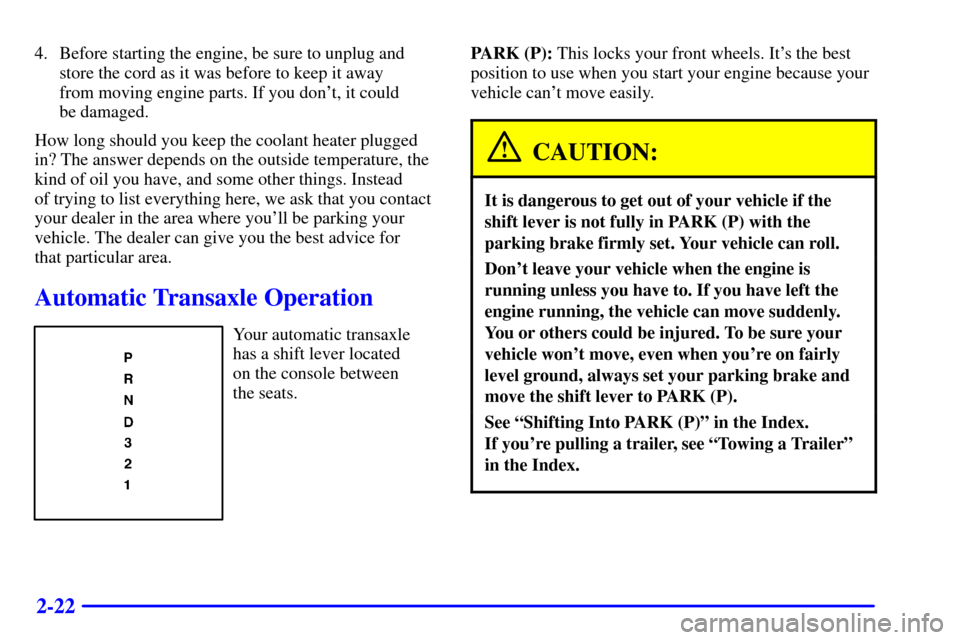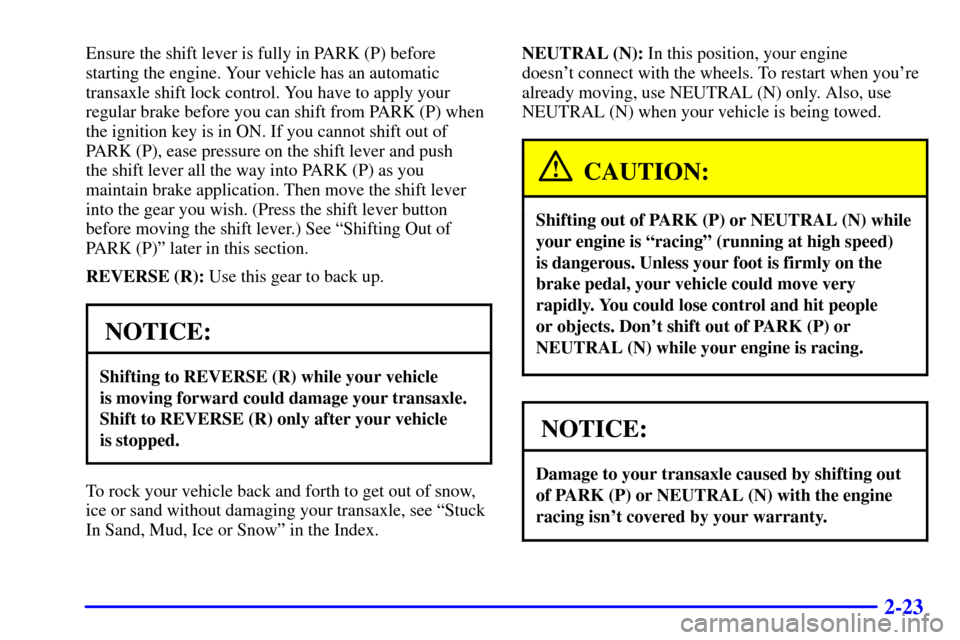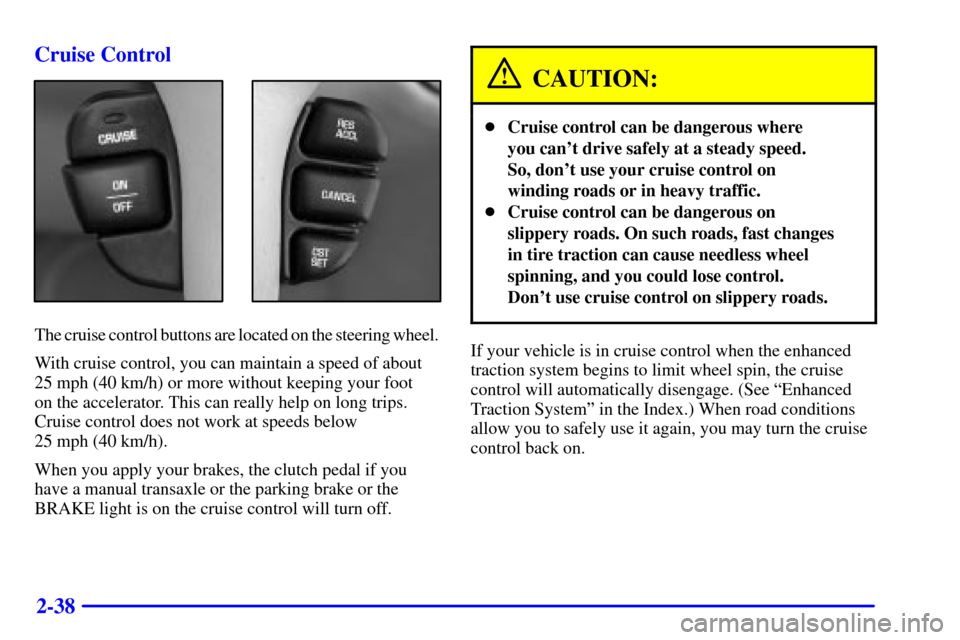Page 66 of 327

2-
2-1
Section 2 Features and Controls
Here you can learn about the many standard and optional features on your vehicle, and information on starting,
shifting and braking. Also explained are the instrument panel and the warning systems that tell you if everything is
working properly
-- and what to do if you have a problem.
2
- 2 Keys
2
- 4 Door Locks
2
- 9 Remote Lock Control (If Equipped)
2
- 13 Trunk
2
- 15 Theft
2
- 16 Passlock�
2- 16 New Vehicle ªBreak-Inº
2
- 17 Ignition Switch
2
- 18 Starting Your Engine
2
- 20 Engine Coolant Heater (If Equipped)
2
- 22 Automatic Transaxle Operation
2
- 25 Manual Transaxle Operation
2
- 27 Parking Brake
2
- 28 Shifting Into PARK (P)
(Automatic Transaxle Only)
2
- 30 Shifting Out of PARK (P)
(Automatic Transaxle Only)
2
- 30 Parking Your Vehicle
(Manual Transaxle Models Only)2
- 31 Parking Over Things That Burn
2
- 31 Engine Exhaust
2
- 32 Running Your Engine While You're Parked
(Automatic Transaxle)
2
- 33 Windows
2
- 34 Tilt Wheel
2
- 34 Turn Signal/Multifunction Lever
2
- 41 Exterior Lamps
2
- 44 Interior Lamps
2
- 46 Mirrors
2
- 47 Storage Compartments
2
- 48 Ashtray and Lighter (If Equipped)
2
- 48 Sun Visors
2
- 49 Auxiliary Power Accessory Outlet
2
- 49 Sunroof (If Equipped)
2
- 50 Instrument Panel - Your Information System
2
- 54 Warning Lights, Gages and Indicators
Page 87 of 327

2-22
4. Before starting the engine, be sure to unplug and
store the cord as it was before to keep it away
from moving engine parts. If you don't, it could
be damaged.
How long should you keep the coolant heater plugged
in? The answer depends on the outside temperature, the
kind of oil you have, and some other things. Instead
of trying to list everything here, we ask that you contact
your dealer in the area where you'll be parking your
vehicle. The dealer can give you the best advice for
that particular area.
Automatic Transaxle Operation
Your automatic transaxle
has a shift lever located
on the console between
the seats.PARK (P): This locks your front wheels. It's the best
position to use when you start your engine because your
vehicle can't move easily.
CAUTION:
It is dangerous to get out of your vehicle if the
shift lever is not fully in PARK (P) with the
parking brake firmly set. Your vehicle can roll.
Don't leave your vehicle when the engine is
running unless you have to. If you have left the
engine running, the vehicle can move suddenly.
You or others could be injured. To be sure your
vehicle won't move, even when you're on fairly
level ground, always set your parking brake and
move the shift lever to PARK (P).
See ªShifting Into PARK (P)º in the Index.
If you're pulling a trailer, see ªTowing a Trailerº
in the Index.
Page 88 of 327

2-23
Ensure the shift lever is fully in PARK (P) before
starting the engine. Your vehicle has an automatic
transaxle shift lock control. You have to apply your
regular brake before you can shift from PARK (P) when
the ignition key is in ON. If you cannot shift out of
PARK (P), ease pressure on the shift lever and push
the shift lever all the way into PARK (P) as you
maintain brake application. Then move the shift lever
into the gear you wish. (Press the shift lever button
before moving the shift lever.) See ªShifting Out of
PARK (P)º later in this section.
REVERSE (R): Use this gear to back up.
NOTICE:
Shifting to REVERSE (R) while your vehicle
is moving forward could damage your transaxle.
Shift to REVERSE (R) only after your vehicle
is stopped.
To rock your vehicle back and forth to get out of snow,
ice or sand without damaging your transaxle, see ªStuck
In Sand, Mud, Ice or Snowº in the Index.NEUTRAL (N): In this position, your engine
doesn't connect with the wheels. To restart when you're
already moving, use NEUTRAL (N) only. Also, use
NEUTRAL (N) when your vehicle is being towed.
CAUTION:
Shifting out of PARK (P) or NEUTRAL (N) while
your engine is ªracingº (running at high speed)
is dangerous. Unless your foot is firmly on the
brake pedal, your vehicle could move very
rapidly. You could lose control and hit people
or objects. Don't shift out of PARK (P) or
NEUTRAL (N) while your engine is racing.
NOTICE:
Damage to your transaxle caused by shifting out
of PARK (P) or NEUTRAL (N) with the engine
racing isn't covered by your warranty.
Page 90 of 327

2-25
FIRST (1): This position gives you even more power
(but lower fuel economy) than SECOND (2). You can
use it on very steep hills, or in deep snow or mud.
If the selector lever is put in FIRST (1), the transaxle
won't shift into first gear until the vehicle is going
slowly enough.
NOTICE:
If your front wheels can't rotate, don't try to
drive. This might happen if you were stuck in
very deep sand or mud or were up against a
solid object. You can damage your transaxle.
Also, if you stop when going uphill, don't hold
your vehicle there with only the accelerator
pedal. This could overheat and damage the
transaxle. Use your brakes or shift into PARK (P)
to hold your vehicle in position on a hill.
Manual Transaxle Operation
This is your shift pattern.
Here's how to operate you transaxle:
FIRST (1): Press the clutch pedal and shift into
FIRST (1). Then, slowly let up on the clutch pedal as
you press the accelerator pedal.
You can shift into FIRST (1) when you are going less
that 20 mph (32 km/h). If you have come to a complete
stop and it is hard to shift into FIRST (1), put the shift
lever into NEUTRAL and let up on the clutch. Press the
clutch pedal back down. Then shift into FIRST (1).
Page 98 of 327

2-33
Windows
Manual Windows
On a vehicle with manual windows, use the window
crank to open and close each window.
Power Windows (If Equipped)
The power window switches are located on the armrest
of the driver's door. In addition, each passenger door has
a switch for its own window.Auto
-Down Switch
The driver's window switch has an auto
-down feature.
This switch is labeled AUTO. Push the top of the
switch partway, and the driver's window will open a
small amount. If the switch is pushed all the way, the
window will go all the way down.
To stop the window while it is lowering, push the
switch forward. To raise the window, push and hold
the switch forward.
Lock
-Out Switch
On four
-door models, the driver's power window
controls also include a lock
-out switch. When the
lock
-out switch is moved to the left (with the white
stripe showing), the driver and passengers will be able
to use their window switches. Move the lock
-out switch
to the right to stop the passengers from using their
window switches. The driver can still control all the
windows with the lock on.
Horn
You can sound the horn by pressing the horn symbol
on your steering wheel.
Page 99 of 327
2-34
Tilt Wheel
A tilt steering wheel allows you to adjust the steering
wheel before you drive.
You can also raise it to the highest level to give your
legs more room when you exit and enter the vehicle.
To tilt the wheel, hold the steering wheel and pull the
lever toward you.
Move the steering wheel to a comfortable level, then
release the lever to lock the wheel in place.
Turn Signal/Multifunction Lever
The lever on the left side of the steering column
includes your:
�Turn Signal and Lane Change Indicator
�Headlamp High/Low Beam Changer
�Park Lamps and Headlamps Control Switch
Page 103 of 327

2-38 Cruise Control
The cruise control buttons are located on the steering wheel.
With cruise control, you can maintain a speed of about
25 mph (40 km/h) or more without keeping your foot
on the accelerator. This can really help on long trips.
Cruise control does not work at speeds below
25 mph (40 km/h).
When you apply your brakes, the clutch pedal if you
have a manual transaxle or the parking brake or the
BRAKE light is on the cruise control will turn off.
CAUTION:
�Cruise control can be dangerous where
you can't drive safely at a steady speed.
So, don't use your cruise control on
winding roads or in heavy traffic.
�Cruise control can be dangerous on
slippery roads. On such roads, fast changes
in tire traction can cause needless wheel
spinning, and you could lose control.
Don't use cruise control on slippery roads.
If your vehicle is in cruise control when the enhanced
traction system begins to limit wheel spin, the cruise
control will automatically disengage. (See ªEnhanced
Traction Systemº in the Index.) When road conditions
allow you to safely use it again, you may turn the cruise
control back on.
Page 108 of 327

2-43 Automatic Light Control (ALC)
When it is dark enough outside, your Automatic Light
Control (ALC) will turn on your headlamps along with
other lamps such as the taillamps, sidemarker lamps,
park lamps and the instrument panel lights. The radio
lights will also be dim.
Your vehicle is equipped with a light sensor on the top
of the instrument panel under the defroster grill, so be
sure it is not covered. This will cause the ALC system
to be on whenever the ignition is on.
The ALC system may also come on when driving
through a parking garage, heavy overcast weather or a
tunnel. This is normal.
There is a delay in the transition between the daytime
and nighttime operation of the DRL and the ALC
systems so that driving under bridges or bright overhead
street lights does not affect the system. The DRL and
ALC systems will only be affected when the light sensor
sees a change in lighting lasting longer than this delay.
To idle your vehicle with the ALC system off, set the
parking brake while the ignition is off. Then start the
vehicle. The ALC system will stay off until you release
the parking brake.
As with any vehicle, you should turn on the regular
headlamp system when you need it.
Delayed Headlamps
The delayed headlamps feature will continue to
illuminate the headlamps for 20 seconds after the
key is turned to OFF, then the headlamps will
automatically turn off.
To override the 20 second delayed headlamp feature
while it is active turn the turn signal/multifunction lever
up one position and then back to OFF.
Fog Lamps (If Equipped)
The button for your fog lamps is located on the
instrument panel, to the left of the steering wheel,
beside the instrument panel intensity control.
When using the fog lamps, the ignition must be on as
well as the parking lamps or the low
-beam headlamps.
Push the button to turn the fog lamps on. An indicator
light on the button will glow when the fog lamps are on.
Push the button again to turn the fog lamps off.
The fog lamps will turn off whenever the high
-beam
headlamps are turned on. When the high beams are
turned off, the fog lamps will come on again.